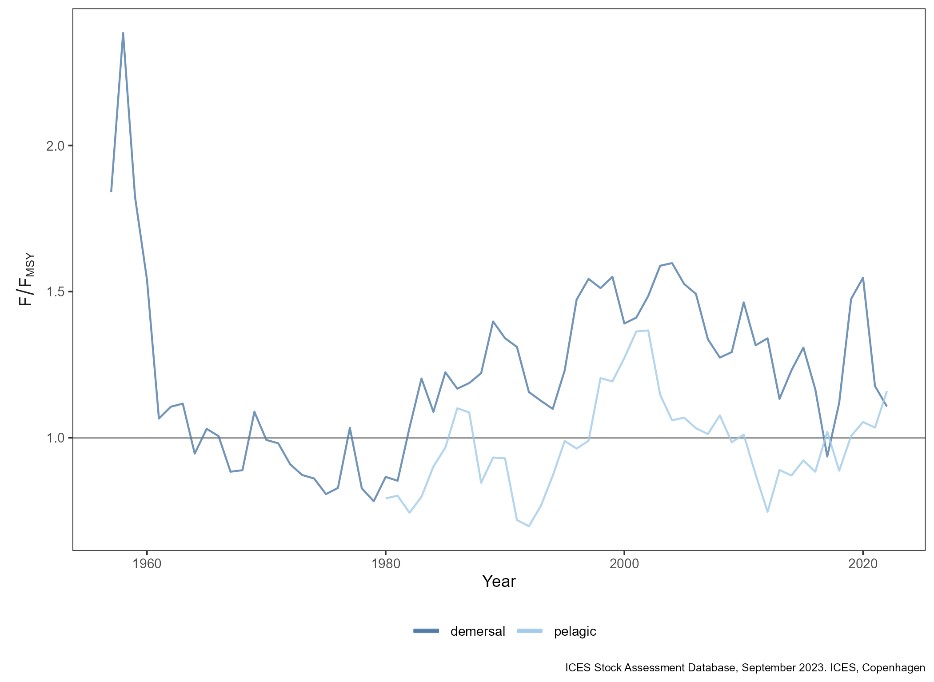The main contributing activity to selective extraction of species in the Faroes ecoregion is commercial fisheries. Demersal fish constituted most of the landings from the 1950s until the late 1980s, after which pelagic landings increased considerably. Landings of demersal fish have remained at low levels since about 2010. Pelagic fish landings have exhibited large fluctuations with the highest landings observed most recently, driven by fisheries targeting blue whiting. Since 2000, total landings (ICES Division 5.b) have ranged between 200 000 and above 600 000 tonnes.
Queen scallop (Aequipecten opercularis) is the only bivalve species of commercial importance in the ecoregion, whose fishery is currently operated by a single vessel. In addition, a limited creel fishery for Norway lobster (Nephrops norvegicus) exists around the islands.
Since 1999, no commercial fisheries for wild Atlantic salmon (Salmo salar) have existed in the ecoregion
Effects on commercial stocks
The fishing pressure (in relation to FMSY) on demersal stocks has decreased since 2000 but is currently above sustainable limits for cod, haddock, ling, and golden redfish. For the pelagic fisheries the fishing pressure has been around FMSY since 2010 with herring and blue whiting fished above FMSY. The mean fishing mortality for demersal fish stocks has shown a declining trend since the early 2000s, but most gadoids stocks are still fished above FMSY (see Figure 4). Detailed information on fisheries is provided in Faroes ecoregion Fisheries Overview.

Figure 4: Time-series of annual relative fishing mortality (F to FMSY ratio) by fisheries guild for demersal and pelagic stocks (see Annex 1 for specific stocks).
European eel (Anguilla anguilla) migrates throughout the Faroes ecoregion as a larval recruit and maturing adult, and its status remains critical. ICES has advised in 2023 that there should be zero eel catches in all habitats. This includes catches in both recreational and commercial fisheries and catches of glass eels for restocking and aquaculture. In addition, all non‑fisheries related anthropogenic mortalities of eel should be zero, and the quantity and quality of eel habitats should be restored.
Recreational and subsistence fishing/harvesting
Residents of the Faroe Islands have the right to go fishing to catch for own consumption; this is considered as recreational fishing. This fishery is normally conducted by small boats (less than 15 GRT) targeting cod, haddock, whiting (Merlangius merlangus), saithe, ling, and tusk (Brosme brosme) with longlines and jigging reels. The subsistence catch of this fishery is not quantified.
In the Faroes, the traditional drive hunt (“grindadráp") usually involves the long-finned pilot whale (Globicephala melas) and occasionally small numbers of Atlantic white-sided dolphin (Leucopleurus acutus). The average annual long-finned pilot whale catches, totals around 600 individuals from an estimated population size (census in 2015) in the Northeast Atlantic of around 380 000Firu.
Effects on non-target species
Many other species not specifically targeted are known to be caught during fishing activities. For example, the squids Loligo forbesi and Todarodes sagittatus are commonly caught as bytcatch in bottom trawls. However, dedicated monitoring on incidental bycatches of endangered, threatened and protected species is very limited within the Faroes ecoregion, mostly being carried out on board foreign vessels fishing in the region. Gillnets are banned in waters of less than 380 m depth around the Faroes, which might reduce both seabird and marine mammal bycatch in the region.
Limited data is available on seabird bycatch. In other areas, longline fisheries are likely to catch seabirds such as northern fulmars (Fulmarus glacialis) and northern gannets (Morus bassanus), as is the case in the nearby Icelandic Waters and Celtic Seas ecoregions. Seabird bycatch may be limited, however, since most of the longline activity occurs during the night.
Fisheries with documented risk of cetacean bycatch in the ecoregion are mainly pelagic trawl ones for mackerel, herring, and blue whiting, all of which have reported bycatch of long-finned pilot whales and minke whales (Balaenopterus acutorostrata).
Discarding by commercial fisheries
Discarding is prohibited by law in commercial fisheries. Discarding in the demersal fisheries is considered negligible; however, there are no reliable estimates of potential discards.

